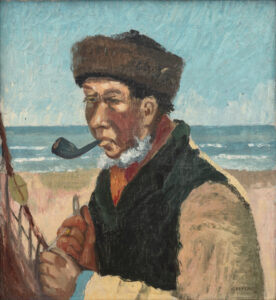Some are convinced that an odd-looking painting found at a garage sale in Minnesota might be a lost work by Vincent van Gogh worth $15 million.
Around 2016, an individual bought a painting at a Minnesota garage sale for $50. The work is a portrait of a fisherman mending a net while smoking a pipe, likely a copy of Portrait of Niels Gaihede by the Danish painter Michael Ancher. The word Elimar is written close to the subject’s sleeve in the bottom right-hand corner. While it is unknown if the buyer had some expertise or connoisseurship of post-Impressionist art, they later approached the Van Gogh Museum in Amsterdam to authenticate the work. In the end, the museum refused to grant their seal of approval. Undeterred, the buyer approached the data science company LMI Group, which purchased the painting and began a thorough analysis of the work. The organization eventually released a four-hundred-fifty-page report detailing its analysis and affirming the work’s authenticity as an “orphaned” work by Vincent van Gogh.
The report spends a hundred pages placing the painting in the context of Van Gogh’s career as if the work’s authenticity is a foregone conclusion. The report mentions Van Gogh’s history of creating copies of other artists work, how he likely got access to a reproduction of the original Ancher painting, Van Gogh’s history of painting the daily lives of working people, the possible literary references contained within the painting, and the idea of the work being a sort of veiled self-portrait. However, once you get past that, LMI dedicates sixty pages to actual evidence-based analysis. Their specialists have pointed out stylistic similarities between Elimar and Van Gogh’s portraits. According to the LMI report, Van Gogh created the work around 1889 while living in an asylum in southern France. LMI notes that Van Gogh made copies of other artists’ work, often using his own style to create something more distinct. Elimar is, therefore, according to the report, not a copy but a “translation” of Ancher’s original. Testing done on the pigments shows they date to the nineteenth century, and that the work was varnished with egg white, something that Van Gogh sometimes did to protect the canvas. LMI specialists even analyzed the word Elimar, comparing the handwriting to samples found in the verified Van Gogh work Still Life with Bible. They even tried to run DNA testing on a loose hair they found trapped in the paint. However, the only conclusion one can reasonably draw from these tests is that the painting was made around when Van Gogh was alive, using materials available to him. A subject’s wrinkles or the use of a palette knife can’t definitively prove a painting’s authorship to the degree LMI is asserting.
Of course, $30,000 worth of tests is more credible than a random hunch. However, would we be talking about this painting if someone in the Midwest didn’t have a possible delusion of grandeur fueled by too many episodes of Antiques Roadshow? It’s possible, but who knows? Personally, I’ve been skeptical of all this since I first heard the story. This may be because I was taught to be suspicious of stories that seem too good to be true. I also think another strike against Elimar’s authenticity is from an aesthetic viewpoint. I just don’t like the painting. It’s not what comes to mind when I think of Van Gogh. Christa Terry, writing for The Observer, remarked something similar; that the portrait “doesn’t have any of the dynamism and vibrancy and movement that define this artist’s work”.
As of writing, the Van Gogh Museum has not responded to LMI’s report.

